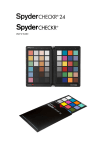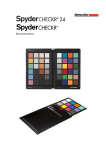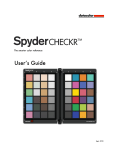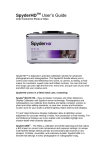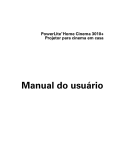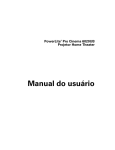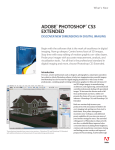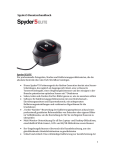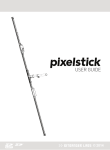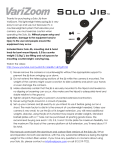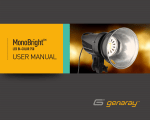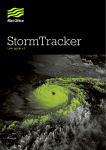Download Reviewer's Guide & User's Guide
Transcript
Reviewer’s Guide & User’s Guide SpyderCHECKR® 24 Reviewer’s Guide Camera Color Correction for Photo & Video The first document included in this PDF is the SpyderCHECKR 24 Reviewers Guide, which contains an introduction to the use and reviewing of the SpyderCHECKR24. The second document included in this PDF is the SpyderCHECKR Users Guide, which provides step-bystep instructions on the use and operation of SpyderCHECKR 24. Table of Contents, Reviewers Guide Pricing: ........................................................................................................................ 3 Product Name & Tagline: ............................................................................................ 3 Product Description: .................................................................................................... 3 Intended Uses ............................................................................................................. 3 What comes in the box: ............................................................................................... 3 Short Description: ........................................................................................................ 4 Product Web Page: ..................................................................................................... 4 System Requirements: ................................................................................................ 4 SpyderCHECKR: Challenges and Solutions ............................................................... 4 What You Will Need: ................................................................................................... 5 What you will be doing: ............................................................................................... 6 Startup: ........................................................................................................................ 6 Technical Questions: ................................................................................................... 8 Product Information: Pricing: Datacolor SKU: MSRP: SCK200 $49.00 / € 42.00 (excl. VAT) Markets and Customers: Still photography, especially location photography Videography, especially location videography Broadcast and Cinema Product Name & Tagline: SpyderCHECKR 24: Camera Color Correction for Photo and Video Product Description: The Datacolor SpyderCHECKR 24 target offers the accuracy of full size, spectrally designed pigment patches, in a thin, portable, affordable color target designed for both still and motion imaging. SpyderCHECKR 24’s gray face provides in-camera and post-process white balance and exposure adjustment, while the color face allows you to color correct your capture automatically in Adobe Photoshop ACR, Adobe Lightroom, Hasselblad Phocus, and Blackmagic DaVinci Resolve. It also facilitates harmonizing color between different cameras, and offers a black and white reverse face for white balancing still and video cameras. Intended Uses • • • As a camera calibration tool, with the new SpyderCHECKR software As an in-camera white balance tool for still and motion As a reference target, for catalog work, fine art reproduction, and all photo and motion capture What comes in the box: • • • • • SpyderCHECKR 24 card SpyderCHECKR 24 slipcover SpyderCHECKR 24 software Quick Start Guide URL SpyderCHECKR 24 serial number *Supported Languages: English, Spanish, French, German, Italian, Russian, Traditional Chinese, Simplified Chinese, Korean, Japanese Short Description: SpyderCHECKR 24 helps capture consistent color from day to day and camera to camera and apply these results easily in your workflow with RAW import software such as, Adobe Photoshop, ACR and Lightroom, Hasselblad Phocus, and Blackmagic DaVinci Resolve. The sturdy, eco-friendly design has 24 spectrally engineered color patches, plus easy to use calibration software - making post production quicker by getting consistent, predictable color from your capture devices right from the start. Product Web Page: http://spyder.datacolor.com/portfolio-view/spydercheckr-24/ System Requirements: • • • • • • • • Your camera (preferably one that supports RAW capture) Win 7 32 & 64, Win 8 32 & 64 Mac OS X 10.7, 10.8, 10.9 1GB of available RAM 500MB of available hard disk space For still imaging: Adobe Lightroom, Adobe Photoshop, or Hasselblad Phocus For video: Adobe Lightroom, Adobe Photoshop, or DaVinci Resolve 11+ Internet access for SpyderCHECKR 24 Software-Download and product activation SpyderCHECKR: Challenges and Solutions Every combination of lens, camera, and sensor has a unique color signature, and this may change in different lighting conditions. And, of course, these devices don’t perceive or record color the way the human eye does. Color control and consistency requires a reference tool to help the user adapt to these variations. Adding color management at the capture stage of one’s digital workflow assures consistency and accuracy from day to day as well as from camera to camera. The SpyderCHECKR 24 target enables the user to create custom camera calibrations, that compensate for the characteristics of the optics and sensors, giving more accurate color reproduction in edited images. The workflow is simple: photograph the SpyderCHECKR 24, import the image into a supported image editor for basic adjustments, open the image in the SpyderCHECKR 24 software, and export the HSL preset. You can apply this preset during image import or editing. The SpyderCHECKR 24 target has 24 spectrally-engineered matte pigment color patches, and easy to use calibration software making post-production quicker by getting consistent, predictable color right from the start. Further information on the SPYDERCHECKR 24 can be found on the Datacolor website. For your convenience, the section below describes the various functions of the product, what you will need to work with one, and a summarized walk-through of its use. For details, see the SpyderCHECKR Users Guide. What You Will Need: • • • • • • • • • The SpyderCHECKR 24 The latest version of SpyderCHECKR software (v1.2 or higher) Image editing software such as Lightroom or Photoshop Video editing software such as Lightroom, Photoshop, or DaVinci Resolve A table, easel or stand to support the SPYDERCHECKR 24 A still camera with RAW capabilities, or a video camera A tripod to support the camera A small hotshoe bubble level to help level the camera on the tripod A small or medium-sized light source on a lightstand What you will be doing: Creating a properly exposed capture of the SpyderCHECKR 24, performing basic editing on that capture, and using that capture to create a colorcorrection pre-set for Lightroom, Photoshop, or Hasselblad Phocus; or import directly into DaVinci Resolve 11. Startup: Download and install the SpyderCHECKR software for your platform from the Datacolor website. Before starting, make sure that you are logged onto your computer as an administrator. Run the installer. (See section on serial number in the User Guide.) This will install a folder in your Datacolor applications folder named SpyderCHECKR. In that folder you'll find an application named SpyderCHECKR. Your serial number is inside your package. It is unique to your copy of the SpyderCHECKR software. Our software uses a web-based activation process, so it’s simplest to install and activate our software from an Internet connected computer. If you install the latest SpyderCHECKR software over an existing copy of the application, it will run without reserializing. However, on launch, the application will be configured for using the 48 patch target. Go to the app’s preferences and change the mode from SpyderCHECKR 48, to SpyderCHECKR 24, to reconfigure for using with the SpyderCHECKR 24 target Workflow Fundamentals (see SpyderCHECKR 24 User’s Guide for details): • • • • • • • Download and install the SpyderCHECKR software on your computer Set up the SPYDERCHECKR 24 lit from 45-degree angle; use even lighting. Carefully eliminate shadows and hot spots. Set up camera at distance where SPYDERCHECKR 24 is in, but does not fill, frame. Make sure camera sensor and SPYDERCHECKR 24 are parallel to each other. Set proper exposure. Keep ISO low. Take photograph in RAW format where possible. Import image of SPYDERCHECKR 24 into your image editing software. Crop to include ONLY the target, and rotate the image so all edges are horizontal and vertical, make appropriate exposure corrections, set white and black points, and set gray balance. Export image in TIFF format, high-bit if possible (no export necessary, if properly configured in Lightroom or Phocus). Open image with SpyderCHECKR Software. • • • • Align SPYDERCHECKR 24 patches with sampling squares Buid and save SPYDERCHECKR 24 preset to your editing application. Relaunch your image editing application, so new Preset will be visible. Open your photographic image(s), and apply Preset in your image editing application via convenient method. You will find that this workflow is easy to execute, and that it provides consistent, repeatable color correction for images captured in a wide range of lighting conditions, including but not limited to outdoor scenes, studio lighting, and difficult artificial lighting. If you have questions about SpyderCHECKR® 24 please contact: Technical Questions: David Saffir Imaging Product Education Manager Datacolor (661) 373-1818 (US West Coast Time) [email protected] Oliver Mews Senior Manager Global IMS Support / Datacolor AG Europe T. +41 44 835 38 30 (MEST) [email protected] Media Relations: Matter Communications [email protected] Datacolor Web Site: http://spyder.datacolor.com User’s Guide SpyderCHECKR & SpyderCHECKR® 24 User’s Guide Camera Color Correction for Photo & Video Table of Contents: Introduction ..................................................................................................................... 11 Operating Requirements: ............................................................................................... 13 SpyderCHECKR Comparison Chart ...................................................................... 14 SpyderCHECKR Workflow Basics ................................................................................. 15 The 48 patch SpyderCHECKR Target ........................................................................... 15 The SpyderCHECKR 24 Target ..................................................................................... 16 Patch Formulation Technology ....................................................................................... 17 Color Patches ................................................................................................................. 17 Patch Groups in the 48 Patch SpyderCHECKR ............................................................. 18 SpyderCHECKR Software: Download, Installation, Basic Setup ................................... 20 Serialization and Activation ............................................................................................ 20 Software Updates ........................................................................................................... 20 Configuring Phocus ........................................................................................................ 22 SpyderCHECKR Setup and Workflow ............................................................................ 23 Mounting Options ........................................................................................................... 23 Uses ............................................................................................................................... 23 Lighting the SpyderCHECKR for photography ............................................................... 23 Opening the Target Shot ................................................................................................ 24 Adjusting the Target Shot ............................................................................................... 25 Saving the Target for use in SpyderCHECKR Application ............................................. 27 Launching the SpyderCHECKR Application ................................................................... 27 Processing your Target Shot In SpyderCHECKR .......................................................... 28 SpyderCHECKR Rendering Modes ............................................................................... 30 Using your new Calibration ............................................................................................ 31 Color Calibrating Cameras for Video in Lightroom ......................................................... 32 Creating Multiple Lightsource Calibrations ..................................................................... 34 Adjusting your Calibration Preset ................................................................................... 34 SpyderCHECKR Gray Target ......................................................................................... 35 Visual Gray Comparisons ............................................................................................... 35 Checking your Display’s Neutrality ................................................................................. 35 In-Camera Color Balancing ............................................................................................ 36 FadeCheckr (Note: provided with 48 Patch Checkr only) ............................................. 36 Changing between 24 and 48 Patch Targets ................................................................. 37 Using SpyderCHECKR with SpyderCUBE ..................................................................... 37 Using SpyderCHECKR with other software ................................................................... 38 More Info ........................................................................................................................ 38 Introduction Digital imaging and color management processes are evolving and becoming more streamlined. Datacolor continues its tradition of creating and supporting photographer and videographer-oriented products, leveraging its expertise in color workflow and technology to help customers express their vision, improve efficiency, and reduce costs. SpyderCHECKR™ provides a fast, reliable method of color calibrating camera, lens, and sensor combinations. It also facilitates harmonizing color between different cameras. It allows photographers to obtain more consistent, accurate color within their normal post-production workflow in Lightroom™, Photoshop™ and Hasselblad Phocus™. It is quite useful in videography, and has been integrated into workflow in applications like Davinci Resolve 11+. The SpyderCHECKR 24, like its larger sibling, offers many of the same features and benefits in a smaller, highly portable design. It uses 24 patches, rather than 48, and eliminates the hard shell case in favor of a slim polymer sleeve. The SpyderCHECKR 24 uses the same software as the original SpyderCHECKR. Advanced amateurs and professionals using SpyderCHECKR technology benefit from optimized color, workflow, and output. From capture, to display, post-production, and final output, Spyder products help make creative workflow quick and accurate. SpyderCHECKR: Challenges and Solutions Every combination of lens, camera, and sensor has a unique color signature, and this may change in different lighting conditions. And, of course, these devices don’t perceive or record color the way the human eye does. Color control and consistency requires a reference tool to help the user adapt to these variations. Adding color management at the capture stage of one’s digital workflow assures consistency and accuracy from day to day as well as from camera to camera. The SpyderCHECKR targets enable the user to create custom camera calibrations, that compensates for the characteristics of the optics and sensors, giving more accurate color reproduction in edited images. Workflow is simple: photograph the SpyderCHECKR, import the image into a supported image editor for basic adjustments, open the image in the SpyderCHECKR software, and export the HSL preset. You can apply this preset during image import or editing. The SpyderCHECKR targets have 24 or 48 spectrally-engineered pigment color patches, and easy to use calibration software making post-production quicker by getting consistent, predictable color right from the start. The SpyderCHECKR includes: • SpyderCHECKR • SpyderCHECKR CD • Quick Start Guide Supported Languages: English, Spanish, French, German, Italian, Russian, Traditional Chinese, Simplified Chinese, Korean, Japanese The SpyderCHECKR 24 includes: • • • • • SpyderCHECKR 24 card SpyderCHECKR 24 slipcover SpyderCHECKR 24 software URL User Guide and Quick Start Guide SpyderCHECKR 24 serial number Supported Languages: English, Spanish, French, German, Italian, Russian, Traditional Chinese, Simplified Chinese, Korean, Japanese SpyderCHECKR 24 Downloads (Software, User´s Guide, Quick Start Guide): http://goto.datacolor.com/getCHECKR24 Operating Requirements: Win 7 32 & 64, Win 8 32 & 64 Mac OS X 10.7, 10.8, 10.9 128MB of available RAM 100MB of available hard disk space For Still Imaging: Adobe Lightroom, Adobe Photoshop, or Hasselblad Phocus For Video: Adobe Lightroom, Adobe Photoshop, or DaVinci Resolve 11+ Internet access for SpyderCHECKR 24 Software-Download and product activation SpyderCHECKR Comparison Chart Feature Datacolor SpyderCHECKR Datacolor SpyderCHECKR 24 Patch Number 48 24 Patch Size Large Large Color Coverage Saturated & Low Saturation Saturated Colors Skintone Patches 8 2 Gray Ramp Patches 13 6 Near White Tints 3 0 Near Black Tones 3 0 Gray Face Large Medium Patch Yes Yes FadeCheckr Yes No Tripod Mount Yes, 1/4" x 20 No Cube Mount Yes, 1/4" x 20 No Rigid Case Yes No Thin, Flexible Case No Yes 31cm wide, 23 cm high, 14cm wide, 20cm high, 1mm 20mm thick thick 15cm wide, 23 cm high, 15cm wide, 21 cm high, 4mm Dimensions Stored 15mm thick thick List Price, $US $139 $49 Large 18% Gray Dimensions Open SpyderCHECKR Workflow Basics The goal of SpyderCHECKR targets is to provide camera calibration that fits conveniently into your workflow, and which is easy to adjust as desired to meet your own needs. Workflow is simple: photograph the SpyderCHECKR, import the image into an approved image editor for basic adjustments, open the image in the SpyderCHECKR software, and export the ‘translation’, or preset. You can apply this preset during image editing. The 48 patch SpyderCHECKR Target The 48 patch SpyderCHECKR closes for storage, opens like a book, and stays securely in its fully open position. Each half of the CHECKR has a frame that holds a color target sheet in place. You can open these frames, and invert the color target sheets to display their gray face. This will expose the SpyderCHECKR Gray Target for visual comparisons, or tasks like In-Camera Custom White Balance. The SpyderCHECKR can be used for visual color comparisons, as well as with a number of third party software packages for camera profiling and other tasks. But most commonly, it is used with the SpyderCHECKR software in creating camera calibrations. The SpyderCHECKR 24 Target The SpyderCHECKR 24 is a compact but very capable version of its larger sibling. It uses the same 24 primary patches from the right side of the SpyderCHECKR to help you create accurate camera calibrations. The reverse side of the target is a gray card and gray ramp. The double-sided card is enclosed in a polymer sleeve, for compactness. Patch Formulation Technology The patches in SpyderCHECKR are composed of pigment-based colors with carefully formulated spectral characteristics, ideal for camera calibration in varying lighting conditions. The SpyderCHECKR also provides spectrally neutral black, white, and gray patches. The patches are durable and produced to close tolerances. A CHECKR which sees only moderate usage will last almost indefinitely. Replacement cards are available for purchase from the Datacolor webstore for circumstances involving heavy use, or in cases where the patches become scratched, worn, or soiled over time. Please avoid touching the patches in your SpyderCHECKR, as oils from the skin can affect the patch color and texture. Color Patches The color patches on the right half of the SpyderCHECKR, and those on the SpyderCHECKR24 represent the standard 24 colors used in a variety of color products. These patches are near or within the sRGB color gamut to avoid gamut clipping, and assure usability with a wide range of capture, display and output devices. Note: the order that various software programs read these standard 24 colors varies, but the SpyderCHECKR provides them in a serpentine pattern, such that reading down one column and up the next will produce the usual measurement order. The color patches in the left half of the 48 patch SpyderCHECKR represent additional colors targeting several uses. There are six additional skintones, for a total of eight. There are six medium saturation color patches, in the red, green, blue, cyan, magenta, and yellow zones, to improve the coverage of the inside of the color gamut. There are three near white tints and three near black tones, for checking color tints and tones at both ends of the dynamic range. And the gray ramp has been increased from the standard 20% steps, to 10% steps, plus extra samples at 5% and 95% to provide a more detailed gray ramp. Patch Groups in the 48 Patch SpyderCHECKR Please note the reference numbers across the left side, and the reference letters across the top of the SpyderCHECKR frame. Gray Patches • • • • • Grays proceed from white (E1) down to black (E6) in 20% steps. Patches D2 to D6 are extra gray patches that provide 10% steps. A zigzag path from A1 to A6 will cover the 10% gray ramp in order. An additional 95% patch is located at D1, and an additional 5% patch is located at C6 for more detail near white and black. The same 10% ramp patches are repeated on the back of the chart, with a large 50% gray patch, for uses requiring neutrals-only to be visible. .Color Patches • • • • • Full saturation patches: Columns F, G, and H Skintones: C1-C5 Near White Tints: B1-B3 Near Black Tones: B4-B6 Med Saturation, RGBCM&Y: A1-A6 SpyderCheckr 24 Patches The patches in SpyderCheckr 24 match those in the right half of the 48 patch SpyderCHECKR described above. Getting Started With SpyderCHECKR SpyderCHECKR Software: Download, Installation, Basic Setup Download and install the SpyderCHECKR software for your platform from the Datacolor website. Before starting, make sure that you are logged onto your computer as an administrator. Run the installer. (See section on Serialization below.) This will install a folder in your Datacolor applications folder named SpyderCHECKR. In that folder you'll find an application named SpyderCHECKR. Lightroom users won't need to launch it from there in general use; it will be self-launching, once you have configured Lightroom. Note: If you use Photoshop, you will import the target image through Adobe CameraRaw (ACR), then you will launch the CHECKR software manually, or by dragging the adjusted image to the application icon to both launch the software and open the image. If you use some other RAW import tool, you'll still need to use ACR to create your calibrations. Once created, you can then use the Sidecar file from ACR in any other application that honors the Adobe Sidecar file format and the adjustments it contains. Serialization and Activation Your serial number is inside your package. It is unique to your copy of the SpyderCHECKR software. Please place this document in an easy to find location for future reference. Our software uses a web-based activation process, so it’s simplest to install and activate our software from an Internet connected computer. Software Updates The software update option in the SpyderCHECKR application (accessible in Preferences) is on by default. When Datacolor posts a new build of the software, it will tell you on next launch that there is an update available, and offer to take you to the Datacolor website to download it. Configuring Lightroom • Go to Lightroom > Preferences • In the External Editing tab, go to the Additional External Editor section, and choose the SpyderCHECKR Editing Preset (which was installed as part of the SpyderCHECKR software installation) • Or: set manually, and go to Application > Choose and navigate to the SpyderCHECKR app in the SpyderCHECKR folder in your Datacolor Folder (in the Applications folder on the Mac). • If you set this manually, you will also need to set the other Additional External Editor settings to File Format > Tiff, and Color Space > AdobeRGB. This does not need to reflect the space you edit or save your images in, it is only for the purpose of exporting target files to the SpyderCHECKR software. Configuring Phocus • Go to the Phocus > Preferences > General > Image Editor>Select. • Navigate to, and select the SpyderCHECKR app in the SpyderCHECKR folder in your Datacolor Folder (in the Applications folder in Macintosh, or the C:\program files\datacolor folder in Windows). • To use the SpyderCHECKR plugin with Phocus, set the Phocus image editor preference to the SpyderCHECKR application in the Datacolor folder. SpyderCHECKR Setup and Workflow Mounting Options The Classic SpyderCHECKR has a standard tripod mount (1/4 inch 20 UNC thread) on the base. This allows flexible mounting at any height or angle desired. However it's also possible to place the target on a table or shelf; it will stand upright in stable locations. There is also a standard tripod stud at the top of the SpyderCHECKR spine. This can be used to mount a SpyderCUBE, but also offers further mounting options. The SpyderCHECKR 24 is a card target, and can be placed as needed, using any type of support desired. A Joby Gorrilapod, or even a plastic business card holder can be used for placing the SpyderCHECKR 24 into a scene. Uses There are numerous uses for a color target, and SpyderCHECKR targets can be used for both visual and digital capture functions. A number of software products, which utilize color targets, can be adapted to work with the SpyderCHECKR. Lighting the SpyderCHECKR for photography Mount the SpyderCHECKR or place in a stable location. Light it from a 45degree angle. The ideal way to light a target is to use a single lightsource, with no reflector or diffuser, from an extended distance. Generally, you would want the sweet spot in the center of the light field to completely overlap the edges of the SpyderCHECKR. This assures that all portions of the target will have the same amount and color of light, reducing fall-off and color variation across the width of a target. A good fluorescent proofing lamp placed in front of the target, with the bulb along the length of the target, shining down from above at 45 degrees, will offer even light. The gray side of the SpyderCHECKR provides an excellent tool for checking lighting consistency. Once the target and lighting are configured, shoot the gray target, and sample the 50% gray area at different locations to check that light quantity, and color, is even. Photographing the SpyderCHECKR Don't fill up the viewfinder frame with the target, because the sweet spot of the lens is near the center, and away from the corners. Its best to shoot the target with a generous amount of border and crop it down later. Use a tripod to support the camera whenever possible. Make sure the camera is directly in front of the target. The central axis of the lens should be in line with the center of the SpyderCHECKR. You can also use another tripod, or a light stand with mount adaptor, to support the SpyderCHECKR target. The SpyderCHECKR 24 can be supported as noted previously. The SpyderCHECKR and the camera sensor should be parallel. Look closely at the shape the target makes: if the rectangle is wider at the top or bottom, or taller at one end than the other, you are not squarely in front of the target. Autofocus produces excellent results. Fully Automatic settings are fine, though Aperture Priority, or full Manual settings are also good for those who are comfortable with them. It is important to shoot in the camera's RAW format, if it offers one. Take a few frames at different settings, if you are unsure of any of the variables. Opening the Target Shot Download your target shot and open in Lightroom, ACR or Phocus, as you would with any RAW image. Adjusting the Target Shot Cropping is done with Lightroom, Phocus or ACR's crop tool. For the 48 patch SpyderCHECKR, crop to the four white dots just outside of the patch area. For the SpyderCHECKR 24, crop to inside the black border, with no background showing beyond the target. Use the rotate function of the crop tool to straighten the target image. Activating Lightroom’s lens profile function will reduce lens distortion in your target shot, but this is rarely necessary. Any of the light or medium gray patches can be used to gray balance/white balance your image in Lightroom, Phocus or ACR. The 20% gray patch (E2) is recommended. Use the white balance eyedropper tool in Lightroom's Develop mode, or from the upper tool palette in ACR. Click on the desired gray patch. Next look at RGB values or Percentages of the White patch (E1). Adjust the exposure slider until the white patch lists as approximately 90% in Lightroom, or about RGB 230, 230, 230 in ACR. Next check the black (E6). The Blacks adjustment (or in some cases the Shadows adjustment) is used to set the black value to 4% in Lightroom, or RGB 10, 10, 10 in ACR. If the value is below this level, it may be best to leave it as shot, or reshoot with brighter illumination. In Phocus, put two color indicators on the brightest and darkest patches (E1, E6) to see the RGB values for each. Now adjust the exposure slider to a white level of 230. The shadows will be set with the black slider, below the histogram, to a level of 10. Now crop and rotate the image to contain only the SpyderCHECKR. Confirm your selection with a click on the Tool icon. Export the image in TIFF format and 16-bit color depth. Click on “Open in Image Editor” to open the resulting file directly from the SpyderCHECKR software. Saving the Target for use in SpyderCHECKR Application If you configured SpyderCHECKR as your optional editing app in Lightroom, you can trigger the export of your adjusted, cropped image by going to Menu > Photo > Edit In > SpyderCHECKR (available in any Mode, but you will typically be in Develop mode). If you are using ACR, you will need to save the image to the desktop or some other appropriate location. Save as a Tiff file, in AdobeRGB. Phocus also allows direct triggering of the SpyderCHECKR app, if preconfigured as an editing app. Launching the SpyderCHECKR Application Checkr will auto-launch if you have set it up correctly in Lightroom, and will open with your target image already imported into the Checkr application. Choose “Edit a Copy with Lightroom Presets” to assure that your white balance and exposure adjustments are included in the exported file. For ACR, go to the Checkr application's folder, double click on the Checkr app, and it will launch itself. Now drag your target file from the desktop into Checkr to import (you can also use the "Open" command from the menu). Processing your Target Shot In SpyderCHECKR If you captured your image and cropped appropriately the sampling squares should already be placed within the correct patches of your Target shot,. If not, you can drag on any edge or corner of the image area to adjust the fit. The colors inside the sampling squares should be a somewhat less saturated version of the patch colors. If the patch and sample colors are of different colors, check that your 48 patch target image is not upside down, sideways, or inverted; the SpyderCHECKR 24 target is automatically rotated to the correct orientation. This shows the 48 patch SpyderCHECKR image upside down. It must be oriented correctly when using the software. Once you have reviewed the location and orientation of the target image, click on the "Save Calibration To..." button and your calibration corrections will be calculated. You will have selected ACR, Lightroom, or Phocus in advance, and will now be prompted to name your new calibration preset. This should include the name of the camera, and might include other data, such as lightsource or lens used. SpyderCHECKR Rendering Modes In SpyderCHECKR's Preferences pane you will find a pop down list of mode choices. The three modes are described below: • • • Colorimetric mode should offer the most literal results, and is best when attempting to reproduce artwork or product colors. Saturation mode offers results, which are generally more pleasing for many types of images. Portrait mode selectively reduces the color saturation of the skintone components to make portrait processing easier. The effects of these modes are subtle, and may not be noticeable on some images. Using your new Calibration Relaunch Lightroom, Phocus or ACR (your calibration data will NOT be available to you until you quit and restart Lightroom, Phocus or ACR), and select an image shot with the same camera or camera and lens combination. Apply your preset from the User Presets list in the Develop mode of Lightroom or from Load Settings in the pop down menu to the right of the mode name (Basic, etc.) in ACR. The changes from applying your calibration data should be subtle; the better your camera's native color, the less effect the calibration will produce. Once you have examined the results on a number of images of different types, and made sure it offers what you need, you can apply it to multiple images at once in Lightroom by selecting the images and then choosing the Preset. For ACR, applying settings to multiple images is done in Adobe Bridge. Color Calibrating Cameras for Video in Lightroom SpyderCHECKR produces color correction presets for a number of applications, including Lightroom, ACR, Davinci Resolve 11, and Phocus. These presets are typically applied to still images processed in these applications. Lightroom can now catalog, clip, and even make basic adjustments to your video, the question of using SpyderCHECKR Lightroom Presets to correct color for your video cameras arises. This possibility is particularly interesting when it comes to adjusting video capture from different types of cameras, such as GoPro cameras and DSLRs, or different types of DSLRs, to match their color as closely as possible. it is possible to apply an existing SpyderCHECKR preset, from a still image shot with your camera, to video shot with the same camera. However, since that preset was most likely shot in RAW, and certainly as a still image, its best to start from scratch, and shoot the SpyderCHECKR target in a video clip, to capture the actual video workflow for color correction. You can then capture a still frame from the video, and process that still frame the same way you would any SpyderCHECKR target shot. The resulting Preset can then be applied to a still image, and by selecting that still image and one or more video clips, the Sync Settings button can then be used to apply the color corrections to video clips. The dialog box shown below will appear, showing which of the Lightroom Development Settings can be applied to video. Be sure the Color Adjustments box is checked, so that the HSL Adjustments from SpyderCHECKR will be applied to the video clips. Once the clips have been color corrected for the camera they have been shot with, they can be exported from Lightroom for processing in any other Video Editing application you use. Be sure to check the Include Video Files checkbox. Creating Multiple Lightsource Calibrations SpyderCHECKR's Tools menu contains commands for creating multiple calibrations from any two existing Lightroom or ACR calibration presets. Choose any two presets built for the same camera, and a series of three new calibration presets will be created which offer increased precision for light sources between the original sources. This function is of use mainly for advanced processes such as museum photography. Adjusting your Calibration Preset The SpyderCHECKR color calibration adjustments are visible in Lightroom or ACR in the Hue, Saturation, Brightness section. This makes it easy for the user to make adjustments to the calibration. For example: if your printer prints skies that tend to be too purple under some lighting conditions, and you need to avoid adding too much magenta ink to the sky tones; you can adjust the blue sliders in the HSL section to control this. Or, if your method of lighting portrait shots requires a different degree of saturation in the skintones, then the orange sliders in HSL can be adjusted to meet those needs. The edited settings can then be saved under a new name to provide a customized color calibration preset SpyderCHECKR Gray Target The inverse face of each CHECKR (SpyderCHECKR on the left, SpyderCHECKR 24 on the right, above) target sheet holds the neutral target patches. These patches consist of the same gray ramp in 10% steps or, in the case of the SpyderCHECKR 24, 20% as the color face of the target. All colored patches have been removed, to allow for improved neutral perception by the viewer. An enlarged 50% gray patch has been added for uses requiring a larger gray sample. Visual Gray Comparisons The SpyderCHECKR Gray Target can be used for various types of visual comparisons. Please keep in mind that visual comparisons of neutrals is a very subtle process, and that it cannot work effectively if bright colors are in the field of view. That's why we provide the Gray Targets on a separate face, as viewing the neutral patches on the Color Target sides will not offer precise results. Be sure to eliminate colored elements from all other visual fields. Checking your Display’s Neutrality It’s possible to use the SpyderCHECKR Gray Target to validate the neutrality of your monitors. Place the CHECKR, with the Gray Target visible, against a neutral background under a medium color temperature, high CRI proofing light, or in a proofing box, that is visible at the same time as your monitor. Dimming ambient lighting, avoidance of backlight, and avoidance of colored objects in your field of view are all important to this process. As your eye adapts to the gray balance of the SpyderCHECKR, shift your gaze to a totally neutral image on a totally neutral background on your display (the Black and White images in the Datacolor SpyderProof Matrix image are intended for this type of use). Shift your gaze back and forth carefully between the CHECKR and the screen, and see if the screen appears to have a different color tone from the neutrals in the CHECKR. If so, you may wish to change your calibration target for your display, to provide neutrals that will match those under your proofing light. In-Camera Color Balancing Shoot the Gray Target face of the SpyderCHECKR in your camera's White Balance or Gray Balance mode to produce an in-camera color balance for the lighting conditions under which you have shot the CHECKR. This will assure that your initial view of images, quick exports to Jpg, or images downloaded directly to the iPad will have the intended color balance, and will assist in assuring that you do not overexpose as you shoot. The mix of several levels of gray in the Gray Target will provide a more global balance than shooting just one density of gray. Shooting the center section of the Gray Target will further enhance this multi-level function. FadeCheckr (Note: provided with 48 Patch Checkr only) The FadeCheckr patch is provided to assist users in determining how much light exposure their SpyderCHECKR target has had. It is designed to fade from red to yellow after the equivalent of 30 days of full sun in the summer. This degree of exposure is sufficient to justify replacing your CHECKR Target Sheets; new sets will be available for purchase from Datacolor.com. Changing between 24 and 48 Patch Targets The SpyderCHECKR software supports both the 24 and 48 patch versions of the SpyderCHECKR target, and will automatically launch configured for the target type you have purchased. If you use both targets, then switching between them occurs in SpyderCHECKR preferences. Select the other target type, and when the dialog box comes up telling you that it is necessary to restart the application to switch, select OK, to auto-quit the SpyderCHECKR app, then relaunch, and it will now use the other target size. Using SpyderCHECKR with SpyderCUBE Once a camera calibration has been produced, and is being used to process images, it is then possible to coordinate this workflow with the SpyderCUBE. The CUBE can be used in the standard manner to determine the optimum whitepoint, exposure, black level and other basic light condition settings for a series of images. The resulting adjustments can be applied separately from applying the SpyderCHECKR color calibration preset, or for convenience, the SpyderCUBE adjustments can be built on top of the SpyderCHECKR preset, and saved as a composite Color/Lighting correction preset. This workflow eliminates the need to carry a color target with you, and avoids building color calibration from casual site shots of a color target. It is much simpler to shoot the SpyderCUBE on location if the lighting conditions are challenging, and combining that with a carefully built SpyderCHECKR color calibration preset. If doing special work under a specific lightsource, shooting the SpyderCHECKR as a reference, to create a custom calibration for the situation if needed, is a good safety measure. Using SpyderCHECKR with other software The SpyderCHECKR, or SpyderCHECKR 24 target can be used with third party software products as well. To utilize it with software designed to accept the standard 24 patches, measure the patches in the appropriate order (which varies with different software) by measuring the last four columns E-H, or the entire 24 patch target in the appropriate pattern, to produce the needed patch order. To use 24 or 48 patches in software that allows custom patch sets, measure the patches in appropriate order. Save your custom measurement set in the format required by the software. Some third party software offers direct support for the SpyderCHECKR target. This includes DaVinci Resolve 11, for video color correction. More Info Please visit the Datacolor website for more information on the SpyderCHECKR line, and our other Spyder products: spyder.datacolor.com






































